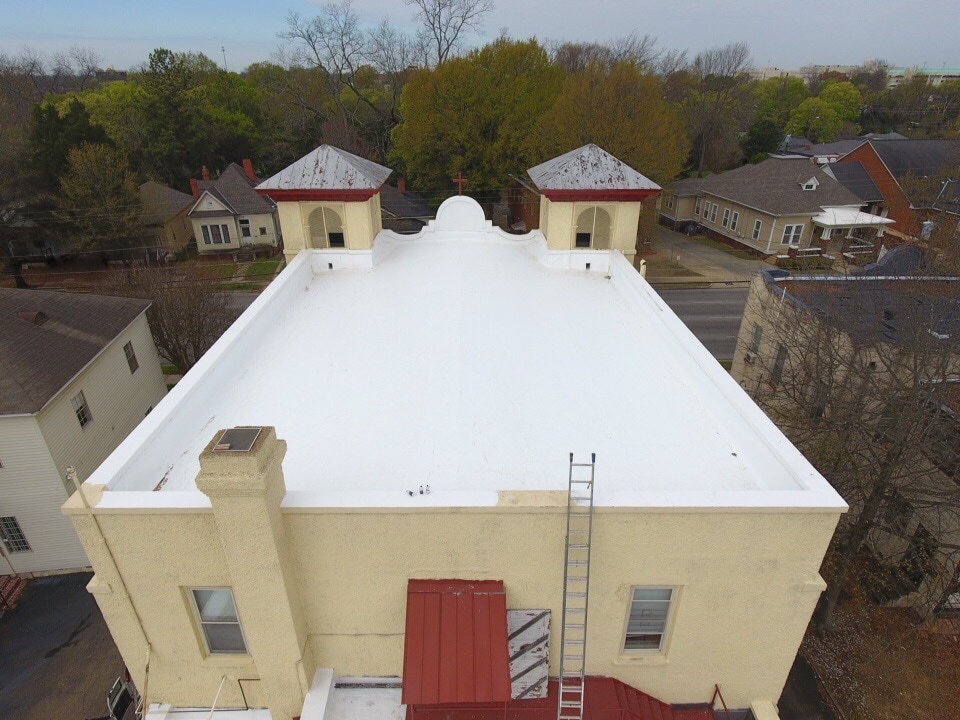In the summer of 2017, we installed a new TPO roof on a historic church in downtown Montgomery, AL. Built in 1925, St. John the Baptist Catholic church has had several roof replacements over the nearly 100 years it’s been in Montgomery, AL.
Roof Assessment
Despite the multiple roof replacements, the roof still had several chronic leaks. However, like a lot of older roofs, the roof was never actually replaced, but layers of new roofing were installed on top of the old roofs. In roofing jargon this is called a layover, and not something that we recommend with historic properties. Historic roofs, anything over 60 years old, usually will have decking issues that need to be addressed and/or cannot support the weight of multiple roof systems. The chronic roof leaks were isolated towards drainage areas, but the current top layer of roofing was near the end of it’s functioning life, so we recommended a total roof replacement.
We did a core sample of the roof to determine how many layers were actually on the roof. We found four distinguishable layers of roofing. The bottom layer, the layer attached directly to the wood deck substrate, was the the most interesting. It was 90 year-old stamped metal, buried underneath (3) layers of roofing. Once we removed all layers of roofing, including the stamped metal, we found a beautiful wood. My favorite part of replacing historical roof is seeing the wood deck after removing all the old roofing material. The wood has been unseen and untouched for years. And even though a lot of the wood usually needs to be replaced, a good portion of most older roofs keep its original structural integrity. The framing is always made of true 2″x’s and the old growth pine lumber takes longer to rot, even when moisture is present. We removed all layers of roofing down to the original wood deck. Despite the chronic roof leaks and age of the roof, the decking was in fairly good condition.
TPO Roof Installation
We replaced a couple hundred linear of 1″x8″ board sheathing and cancelled (2) vents that were no longer in use. We’ve learned from years of experience (sometimes the hard way) that properly preparing a roof deck, especially on an roof, is one of the most important components to a new roof system. Once the deck was prepared we installed a synthetic moisture barrier over the entire roof. Then to provide a smooth substrate for the TPO roof, we installed 1″ insulation boards. The insulation boards were mechanically attached to the wood deck with screws and plates. When working on commercial roofs it’s important to place mechanical fasteners in a systematic and consistent way to protect against wind up lift. Each of the 4’x8′ insulation boards received no less than (6) fasteners.
We used .60 mil GAF, bright white TPO. To minimize the number of seams in the roof we used 10’x100′ rolls of TPO. These wider rolls are harder to get on the roof and control, but once installed they r limit the number of seams on the roof. Roof leaks on commercial roofs usually happen at the seams or around obstructions. However, because TPO is heat welded, the seam becomes the strongest and thickest part of the roof system. If seams are welded correctly they fuse together and form a monolithic sheet. We mechanically attached all the TPO placing the fasteners every 6″ for superior wind uplift protection. We used a welding robot to heat weld all of the seams in the field of the roof and hand welders around the perimeters and obstructions. This TPO roof system carriers a 20-year manufacturer warranty and a 5-year workmanship warranty.





Copyright © 2017 Guyette Roofing and Construction LLC | All Right Reserved

